Analysis of US FCC Digital Business Strategies and Change Management
VerifiedAdded on 2022/09/20
|7
|2848
|24
Report
AI Summary
This report provides a comprehensive analysis of the US Federal Communications Commission's (FCC) digital business strategies and change management initiatives, focusing on its successful IT modernization. The analysis employs two key frameworks: Kotter's eight steps for organizational transformation and Fernandez and Rainey's eight factors influencing change initiatives. The report details the FCC's transformation journey, including the initial assessment by the new CIO, the inventory of IT infrastructure, stakeholder engagement, and the move to cloud environments. It highlights the significant reductions in IT expenses and the improved efficiency in system deployment. The analysis applies both frameworks to evaluate the FCC's approach, examining how the organization established a sense of urgency, formed a guiding coalition, communicated a vision, empowered employees, created short-term wins, and institutionalized changes. The discussion section reflects on the lessons learned, emphasizing the importance of a combined strategy for IT systems and people, clear planning, quick wins, and continuous change management. The report concludes by presenting the FCC case as an example of successful public sector transformation, offering valuable insights for future leaders undertaking similar change efforts.
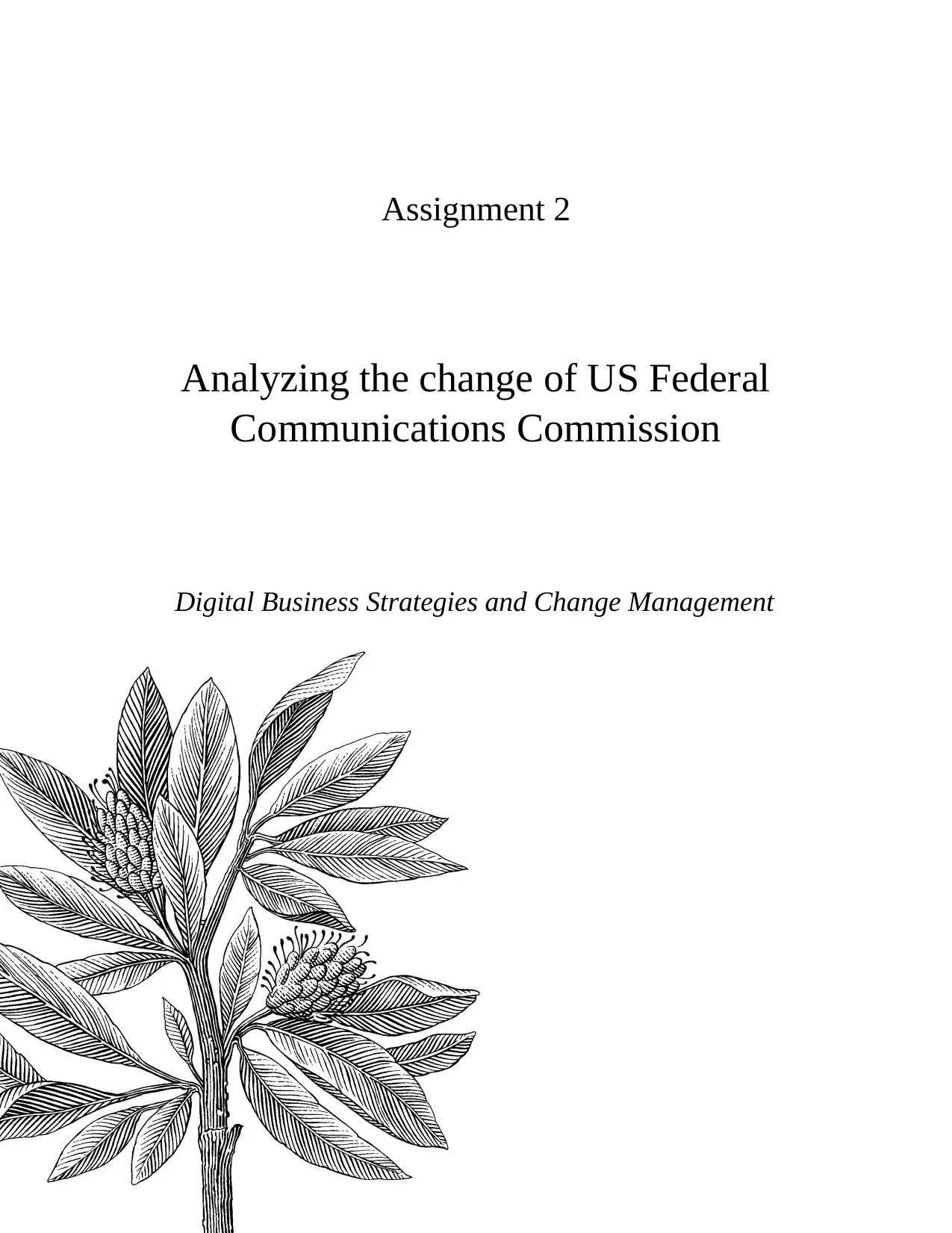
Assignment 2
Analyzing the change of US Federal
Communications Commission
Digital Business Strategies and Change Management
Analyzing the change of US Federal
Communications Commission
Digital Business Strategies and Change Management
Paraphrase This Document
Need a fresh take? Get an instant paraphrase of this document with our AI Paraphraser
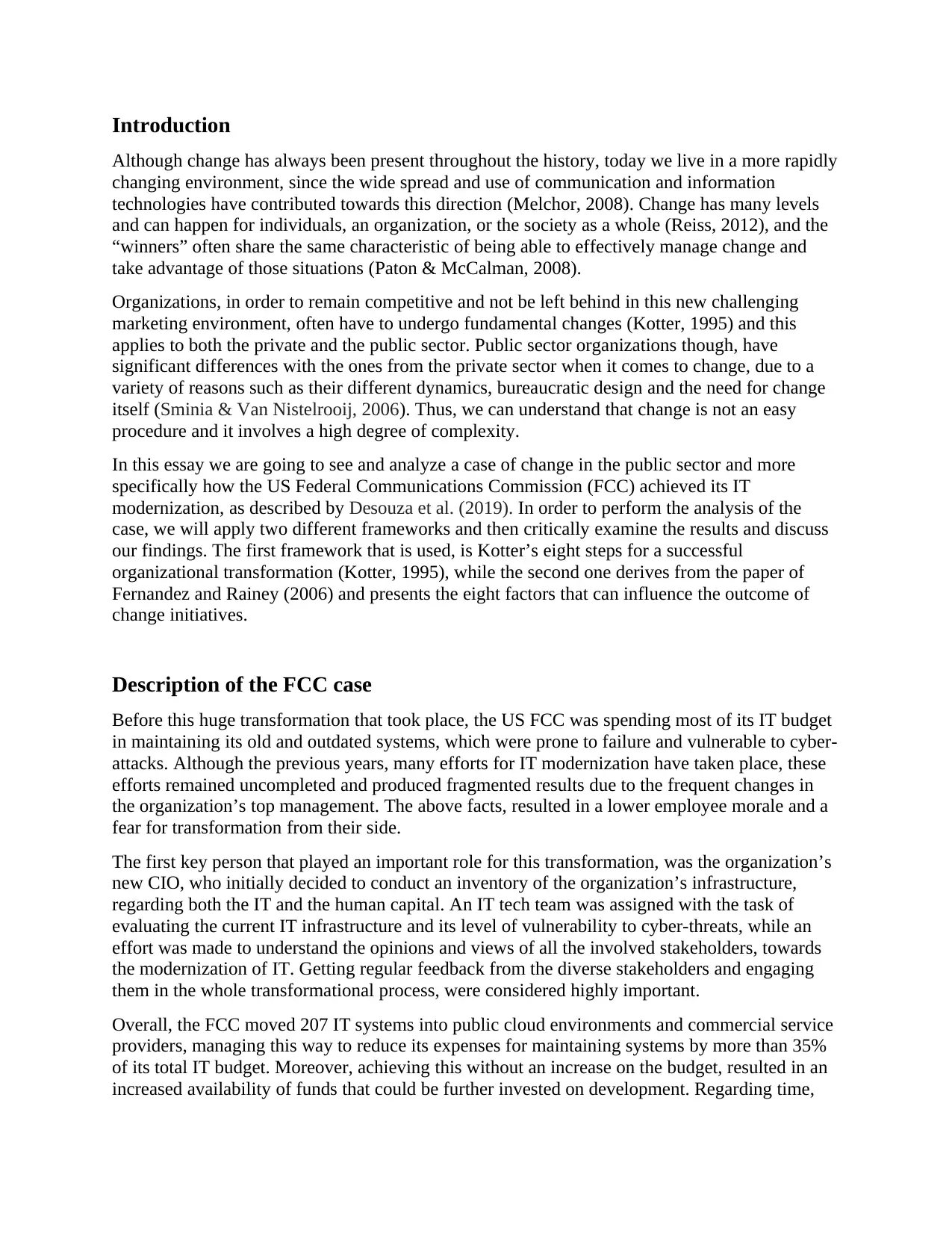
Introduction
Although change has always been present throughout the history, today we live in a more rapidly
changing environment, since the wide spread and use of communication and information
technologies have contributed towards this direction (Melchor, 2008). Change has many levels
and can happen for individuals, an organization, or the society as a whole (Reiss, 2012), and the
“winners” often share the same characteristic of being able to effectively manage change and
take advantage of those situations (Paton & McCalman, 2008).
Organizations, in order to remain competitive and not be left behind in this new challenging
marketing environment, often have to undergo fundamental changes (Kotter, 1995) and this
applies to both the private and the public sector. Public sector organizations though, have
significant differences with the ones from the private sector when it comes to change, due to a
variety of reasons such as their different dynamics, bureaucratic design and the need for change
itself (Sminia & Van Nistelrooij, 2006). Thus, we can understand that change is not an easy
procedure and it involves a high degree of complexity.
In this essay we are going to see and analyze a case of change in the public sector and more
specifically how the US Federal Communications Commission (FCC) achieved its IT
modernization, as described by Desouza et al. (2019). In order to perform the analysis of the
case, we will apply two different frameworks and then critically examine the results and discuss
our findings. The first framework that is used, is Kotter’s eight steps for a successful
organizational transformation (Kotter, 1995), while the second one derives from the paper of
Fernandez and Rainey (2006) and presents the eight factors that can influence the outcome of
change initiatives.
Description of the FCC case
Before this huge transformation that took place, the US FCC was spending most of its IT budget
in maintaining its old and outdated systems, which were prone to failure and vulnerable to cyber-
attacks. Although the previous years, many efforts for IT modernization have taken place, these
efforts remained uncompleted and produced fragmented results due to the frequent changes in
the organization’s top management. The above facts, resulted in a lower employee morale and a
fear for transformation from their side.
The first key person that played an important role for this transformation, was the organization’s
new CIO, who initially decided to conduct an inventory of the organization’s infrastructure,
regarding both the IT and the human capital. An IT tech team was assigned with the task of
evaluating the current IT infrastructure and its level of vulnerability to cyber-threats, while an
effort was made to understand the opinions and views of all the involved stakeholders, towards
the modernization of IT. Getting regular feedback from the diverse stakeholders and engaging
them in the whole transformational process, were considered highly important.
Overall, the FCC moved 207 IT systems into public cloud environments and commercial service
providers, managing this way to reduce its expenses for maintaining systems by more than 35%
of its total IT budget. Moreover, achieving this without an increase on the budget, resulted in an
increased availability of funds that could be further invested on development. Regarding time,
Although change has always been present throughout the history, today we live in a more rapidly
changing environment, since the wide spread and use of communication and information
technologies have contributed towards this direction (Melchor, 2008). Change has many levels
and can happen for individuals, an organization, or the society as a whole (Reiss, 2012), and the
“winners” often share the same characteristic of being able to effectively manage change and
take advantage of those situations (Paton & McCalman, 2008).
Organizations, in order to remain competitive and not be left behind in this new challenging
marketing environment, often have to undergo fundamental changes (Kotter, 1995) and this
applies to both the private and the public sector. Public sector organizations though, have
significant differences with the ones from the private sector when it comes to change, due to a
variety of reasons such as their different dynamics, bureaucratic design and the need for change
itself (Sminia & Van Nistelrooij, 2006). Thus, we can understand that change is not an easy
procedure and it involves a high degree of complexity.
In this essay we are going to see and analyze a case of change in the public sector and more
specifically how the US Federal Communications Commission (FCC) achieved its IT
modernization, as described by Desouza et al. (2019). In order to perform the analysis of the
case, we will apply two different frameworks and then critically examine the results and discuss
our findings. The first framework that is used, is Kotter’s eight steps for a successful
organizational transformation (Kotter, 1995), while the second one derives from the paper of
Fernandez and Rainey (2006) and presents the eight factors that can influence the outcome of
change initiatives.
Description of the FCC case
Before this huge transformation that took place, the US FCC was spending most of its IT budget
in maintaining its old and outdated systems, which were prone to failure and vulnerable to cyber-
attacks. Although the previous years, many efforts for IT modernization have taken place, these
efforts remained uncompleted and produced fragmented results due to the frequent changes in
the organization’s top management. The above facts, resulted in a lower employee morale and a
fear for transformation from their side.
The first key person that played an important role for this transformation, was the organization’s
new CIO, who initially decided to conduct an inventory of the organization’s infrastructure,
regarding both the IT and the human capital. An IT tech team was assigned with the task of
evaluating the current IT infrastructure and its level of vulnerability to cyber-threats, while an
effort was made to understand the opinions and views of all the involved stakeholders, towards
the modernization of IT. Getting regular feedback from the diverse stakeholders and engaging
them in the whole transformational process, were considered highly important.
Overall, the FCC moved 207 IT systems into public cloud environments and commercial service
providers, managing this way to reduce its expenses for maintaining systems by more than 35%
of its total IT budget. Moreover, achieving this without an increase on the budget, resulted in an
increased availability of funds that could be further invested on development. Regarding time,
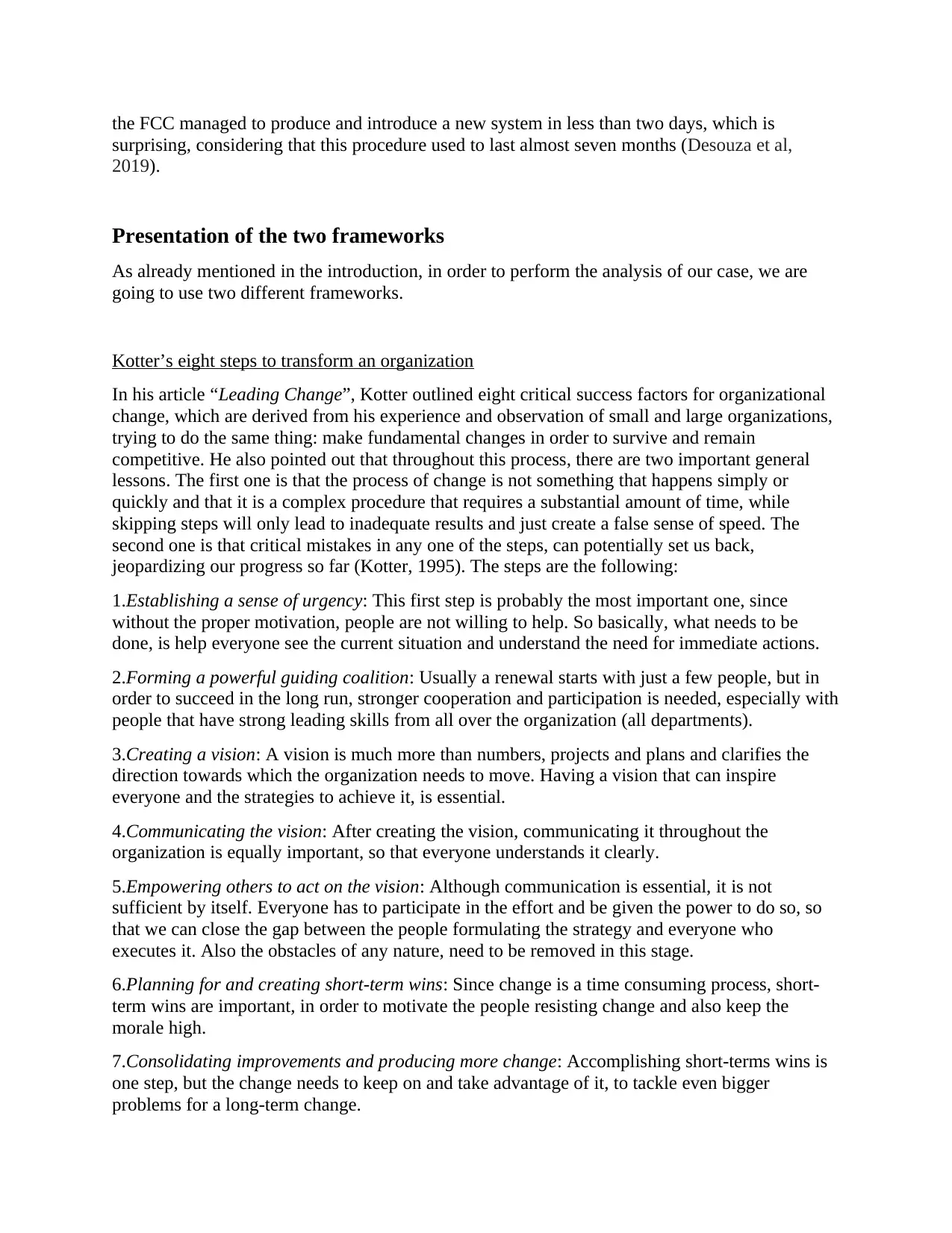
the FCC managed to produce and introduce a new system in less than two days, which is
surprising, considering that this procedure used to last almost seven months (Desouza et al,
2019).
Presentation of the two frameworks
As already mentioned in the introduction, in order to perform the analysis of our case, we are
going to use two different frameworks.
Kotter’s eight steps to transform an organization
In his article “Leading Change”, Kotter outlined eight critical success factors for organizational
change, which are derived from his experience and observation of small and large organizations,
trying to do the same thing: make fundamental changes in order to survive and remain
competitive. He also pointed out that throughout this process, there are two important general
lessons. The first one is that the process of change is not something that happens simply or
quickly and that it is a complex procedure that requires a substantial amount of time, while
skipping steps will only lead to inadequate results and just create a false sense of speed. The
second one is that critical mistakes in any one of the steps, can potentially set us back,
jeopardizing our progress so far (Kotter, 1995). The steps are the following:
1.Establishing a sense of urgency: This first step is probably the most important one, since
without the proper motivation, people are not willing to help. So basically, what needs to be
done, is help everyone see the current situation and understand the need for immediate actions.
2.Forming a powerful guiding coalition: Usually a renewal starts with just a few people, but in
order to succeed in the long run, stronger cooperation and participation is needed, especially with
people that have strong leading skills from all over the organization (all departments).
3.Creating a vision: A vision is much more than numbers, projects and plans and clarifies the
direction towards which the organization needs to move. Having a vision that can inspire
everyone and the strategies to achieve it, is essential.
4.Communicating the vision: After creating the vision, communicating it throughout the
organization is equally important, so that everyone understands it clearly.
5.Empowering others to act on the vision: Although communication is essential, it is not
sufficient by itself. Everyone has to participate in the effort and be given the power to do so, so
that we can close the gap between the people formulating the strategy and everyone who
executes it. Also the obstacles of any nature, need to be removed in this stage.
6.Planning for and creating short-term wins: Since change is a time consuming process, short-
term wins are important, in order to motivate the people resisting change and also keep the
morale high.
7.Consolidating improvements and producing more change: Accomplishing short-terms wins is
one step, but the change needs to keep on and take advantage of it, to tackle even bigger
problems for a long-term change.
surprising, considering that this procedure used to last almost seven months (Desouza et al,
2019).
Presentation of the two frameworks
As already mentioned in the introduction, in order to perform the analysis of our case, we are
going to use two different frameworks.
Kotter’s eight steps to transform an organization
In his article “Leading Change”, Kotter outlined eight critical success factors for organizational
change, which are derived from his experience and observation of small and large organizations,
trying to do the same thing: make fundamental changes in order to survive and remain
competitive. He also pointed out that throughout this process, there are two important general
lessons. The first one is that the process of change is not something that happens simply or
quickly and that it is a complex procedure that requires a substantial amount of time, while
skipping steps will only lead to inadequate results and just create a false sense of speed. The
second one is that critical mistakes in any one of the steps, can potentially set us back,
jeopardizing our progress so far (Kotter, 1995). The steps are the following:
1.Establishing a sense of urgency: This first step is probably the most important one, since
without the proper motivation, people are not willing to help. So basically, what needs to be
done, is help everyone see the current situation and understand the need for immediate actions.
2.Forming a powerful guiding coalition: Usually a renewal starts with just a few people, but in
order to succeed in the long run, stronger cooperation and participation is needed, especially with
people that have strong leading skills from all over the organization (all departments).
3.Creating a vision: A vision is much more than numbers, projects and plans and clarifies the
direction towards which the organization needs to move. Having a vision that can inspire
everyone and the strategies to achieve it, is essential.
4.Communicating the vision: After creating the vision, communicating it throughout the
organization is equally important, so that everyone understands it clearly.
5.Empowering others to act on the vision: Although communication is essential, it is not
sufficient by itself. Everyone has to participate in the effort and be given the power to do so, so
that we can close the gap between the people formulating the strategy and everyone who
executes it. Also the obstacles of any nature, need to be removed in this stage.
6.Planning for and creating short-term wins: Since change is a time consuming process, short-
term wins are important, in order to motivate the people resisting change and also keep the
morale high.
7.Consolidating improvements and producing more change: Accomplishing short-terms wins is
one step, but the change needs to keep on and take advantage of it, to tackle even bigger
problems for a long-term change.
⊘ This is a preview!⊘
Do you want full access?
Subscribe today to unlock all pages.

Trusted by 1+ million students worldwide
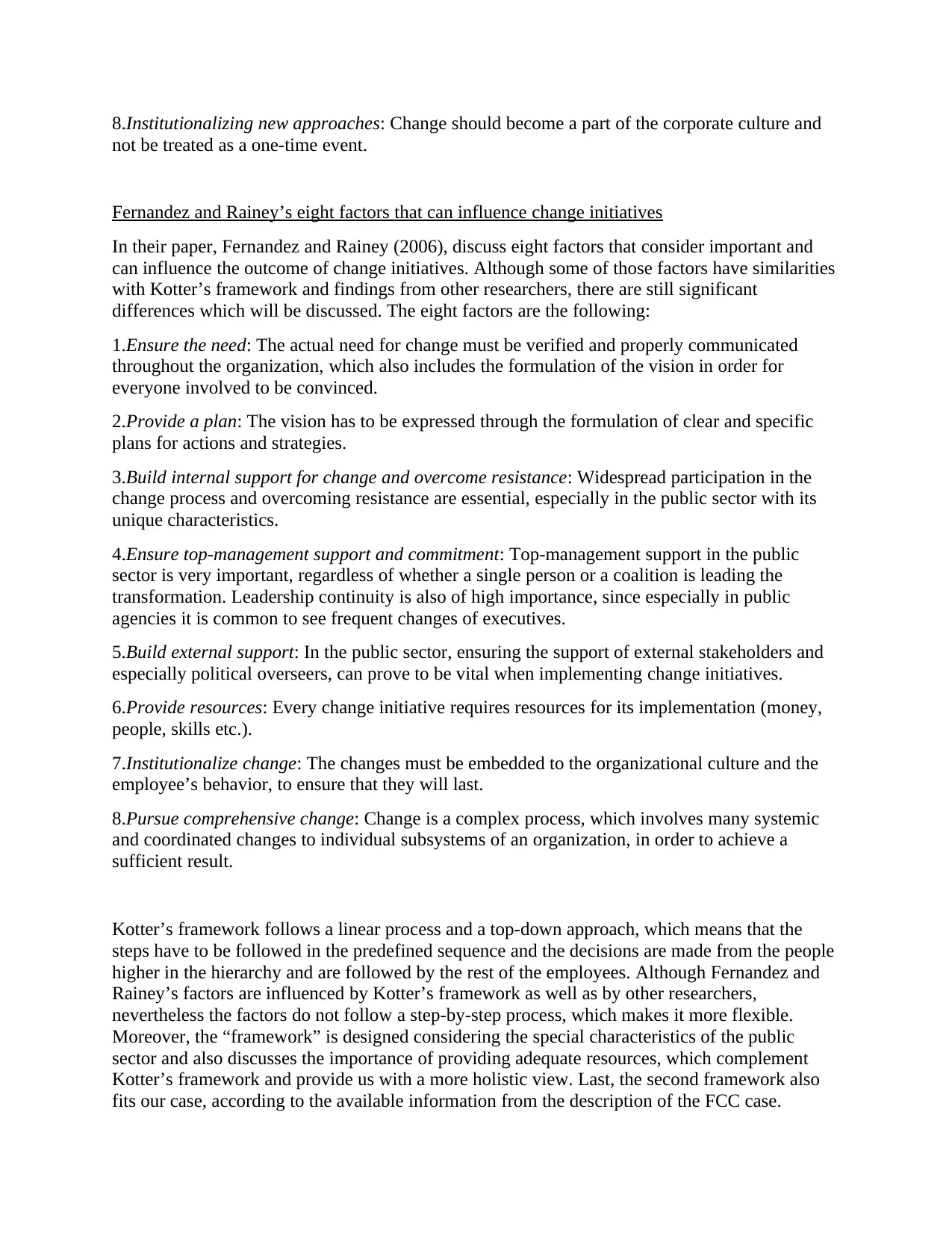
8.Institutionalizing new approaches: Change should become a part of the corporate culture and
not be treated as a one-time event.
Fernandez and Rainey’s eight factors that can influence change initiatives
In their paper, Fernandez and Rainey (2006), discuss eight factors that consider important and
can influence the outcome of change initiatives. Although some of those factors have similarities
with Kotter’s framework and findings from other researchers, there are still significant
differences which will be discussed. The eight factors are the following:
1.Ensure the need: The actual need for change must be verified and properly communicated
throughout the organization, which also includes the formulation of the vision in order for
everyone involved to be convinced.
2.Provide a plan: The vision has to be expressed through the formulation of clear and specific
plans for actions and strategies.
3.Build internal support for change and overcome resistance: Widespread participation in the
change process and overcoming resistance are essential, especially in the public sector with its
unique characteristics.
4.Ensure top-management support and commitment: Top-management support in the public
sector is very important, regardless of whether a single person or a coalition is leading the
transformation. Leadership continuity is also of high importance, since especially in public
agencies it is common to see frequent changes of executives.
5.Build external support: In the public sector, ensuring the support of external stakeholders and
especially political overseers, can prove to be vital when implementing change initiatives.
6.Provide resources: Every change initiative requires resources for its implementation (money,
people, skills etc.).
7.Institutionalize change: The changes must be embedded to the organizational culture and the
employee’s behavior, to ensure that they will last.
8.Pursue comprehensive change: Change is a complex process, which involves many systemic
and coordinated changes to individual subsystems of an organization, in order to achieve a
sufficient result.
Kotter’s framework follows a linear process and a top-down approach, which means that the
steps have to be followed in the predefined sequence and the decisions are made from the people
higher in the hierarchy and are followed by the rest of the employees. Although Fernandez and
Rainey’s factors are influenced by Kotter’s framework as well as by other researchers,
nevertheless the factors do not follow a step-by-step process, which makes it more flexible.
Moreover, the “framework” is designed considering the special characteristics of the public
sector and also discusses the importance of providing adequate resources, which complement
Kotter’s framework and provide us with a more holistic view. Last, the second framework also
fits our case, according to the available information from the description of the FCC case.
not be treated as a one-time event.
Fernandez and Rainey’s eight factors that can influence change initiatives
In their paper, Fernandez and Rainey (2006), discuss eight factors that consider important and
can influence the outcome of change initiatives. Although some of those factors have similarities
with Kotter’s framework and findings from other researchers, there are still significant
differences which will be discussed. The eight factors are the following:
1.Ensure the need: The actual need for change must be verified and properly communicated
throughout the organization, which also includes the formulation of the vision in order for
everyone involved to be convinced.
2.Provide a plan: The vision has to be expressed through the formulation of clear and specific
plans for actions and strategies.
3.Build internal support for change and overcome resistance: Widespread participation in the
change process and overcoming resistance are essential, especially in the public sector with its
unique characteristics.
4.Ensure top-management support and commitment: Top-management support in the public
sector is very important, regardless of whether a single person or a coalition is leading the
transformation. Leadership continuity is also of high importance, since especially in public
agencies it is common to see frequent changes of executives.
5.Build external support: In the public sector, ensuring the support of external stakeholders and
especially political overseers, can prove to be vital when implementing change initiatives.
6.Provide resources: Every change initiative requires resources for its implementation (money,
people, skills etc.).
7.Institutionalize change: The changes must be embedded to the organizational culture and the
employee’s behavior, to ensure that they will last.
8.Pursue comprehensive change: Change is a complex process, which involves many systemic
and coordinated changes to individual subsystems of an organization, in order to achieve a
sufficient result.
Kotter’s framework follows a linear process and a top-down approach, which means that the
steps have to be followed in the predefined sequence and the decisions are made from the people
higher in the hierarchy and are followed by the rest of the employees. Although Fernandez and
Rainey’s factors are influenced by Kotter’s framework as well as by other researchers,
nevertheless the factors do not follow a step-by-step process, which makes it more flexible.
Moreover, the “framework” is designed considering the special characteristics of the public
sector and also discusses the importance of providing adequate resources, which complement
Kotter’s framework and provide us with a more holistic view. Last, the second framework also
fits our case, according to the available information from the description of the FCC case.
Paraphrase This Document
Need a fresh take? Get an instant paraphrase of this document with our AI Paraphraser
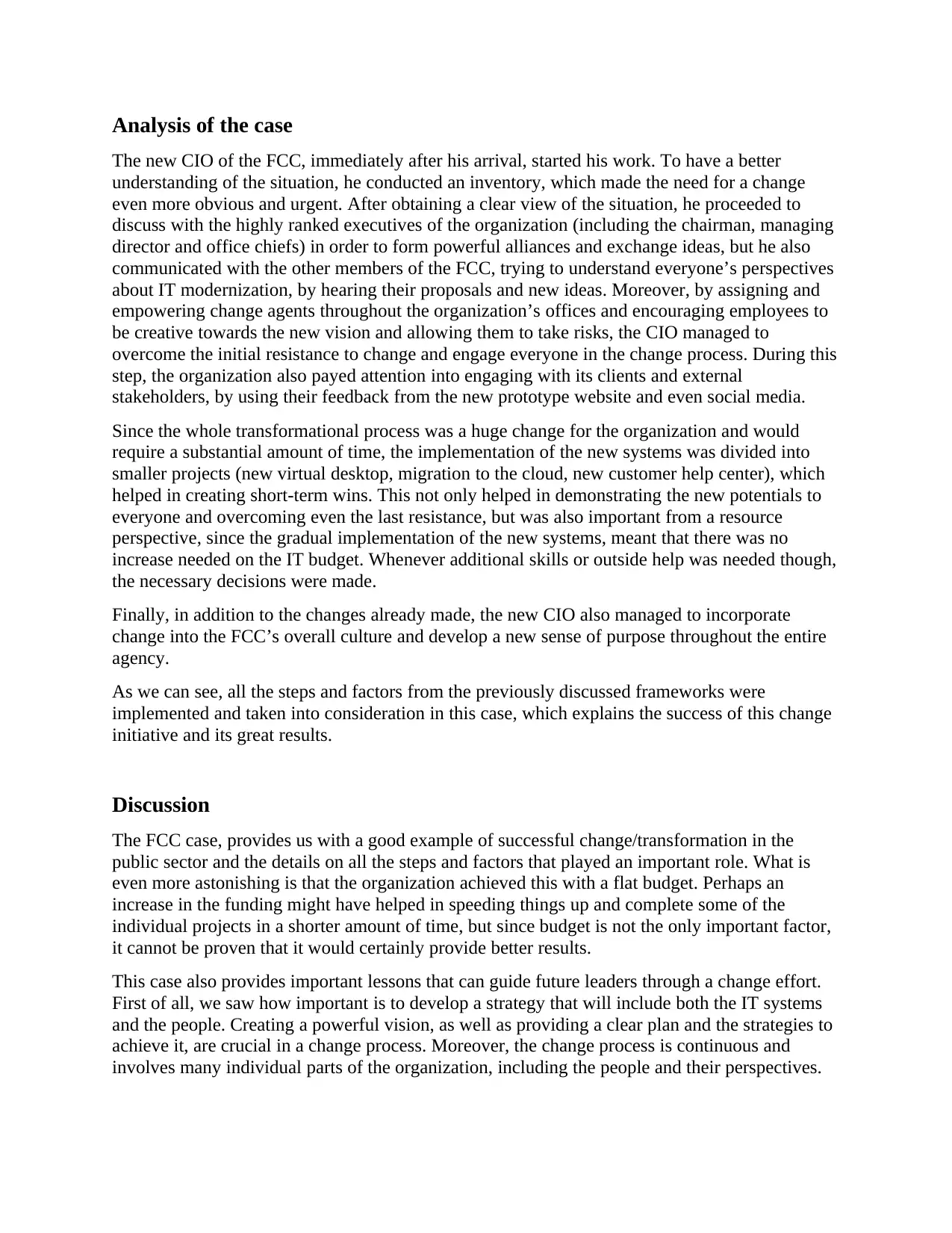
Analysis of the case
The new CIO of the FCC, immediately after his arrival, started his work. To have a better
understanding of the situation, he conducted an inventory, which made the need for a change
even more obvious and urgent. After obtaining a clear view of the situation, he proceeded to
discuss with the highly ranked executives of the organization (including the chairman, managing
director and office chiefs) in order to form powerful alliances and exchange ideas, but he also
communicated with the other members of the FCC, trying to understand everyone’s perspectives
about IT modernization, by hearing their proposals and new ideas. Moreover, by assigning and
empowering change agents throughout the organization’s offices and encouraging employees to
be creative towards the new vision and allowing them to take risks, the CIO managed to
overcome the initial resistance to change and engage everyone in the change process. During this
step, the organization also payed attention into engaging with its clients and external
stakeholders, by using their feedback from the new prototype website and even social media.
Since the whole transformational process was a huge change for the organization and would
require a substantial amount of time, the implementation of the new systems was divided into
smaller projects (new virtual desktop, migration to the cloud, new customer help center), which
helped in creating short-term wins. This not only helped in demonstrating the new potentials to
everyone and overcoming even the last resistance, but was also important from a resource
perspective, since the gradual implementation of the new systems, meant that there was no
increase needed on the IT budget. Whenever additional skills or outside help was needed though,
the necessary decisions were made.
Finally, in addition to the changes already made, the new CIO also managed to incorporate
change into the FCC’s overall culture and develop a new sense of purpose throughout the entire
agency.
As we can see, all the steps and factors from the previously discussed frameworks were
implemented and taken into consideration in this case, which explains the success of this change
initiative and its great results.
Discussion
The FCC case, provides us with a good example of successful change/transformation in the
public sector and the details on all the steps and factors that played an important role. What is
even more astonishing is that the organization achieved this with a flat budget. Perhaps an
increase in the funding might have helped in speeding things up and complete some of the
individual projects in a shorter amount of time, but since budget is not the only important factor,
it cannot be proven that it would certainly provide better results.
This case also provides important lessons that can guide future leaders through a change effort.
First of all, we saw how important is to develop a strategy that will include both the IT systems
and the people. Creating a powerful vision, as well as providing a clear plan and the strategies to
achieve it, are crucial in a change process. Moreover, the change process is continuous and
involves many individual parts of the organization, including the people and their perspectives.
The new CIO of the FCC, immediately after his arrival, started his work. To have a better
understanding of the situation, he conducted an inventory, which made the need for a change
even more obvious and urgent. After obtaining a clear view of the situation, he proceeded to
discuss with the highly ranked executives of the organization (including the chairman, managing
director and office chiefs) in order to form powerful alliances and exchange ideas, but he also
communicated with the other members of the FCC, trying to understand everyone’s perspectives
about IT modernization, by hearing their proposals and new ideas. Moreover, by assigning and
empowering change agents throughout the organization’s offices and encouraging employees to
be creative towards the new vision and allowing them to take risks, the CIO managed to
overcome the initial resistance to change and engage everyone in the change process. During this
step, the organization also payed attention into engaging with its clients and external
stakeholders, by using their feedback from the new prototype website and even social media.
Since the whole transformational process was a huge change for the organization and would
require a substantial amount of time, the implementation of the new systems was divided into
smaller projects (new virtual desktop, migration to the cloud, new customer help center), which
helped in creating short-term wins. This not only helped in demonstrating the new potentials to
everyone and overcoming even the last resistance, but was also important from a resource
perspective, since the gradual implementation of the new systems, meant that there was no
increase needed on the IT budget. Whenever additional skills or outside help was needed though,
the necessary decisions were made.
Finally, in addition to the changes already made, the new CIO also managed to incorporate
change into the FCC’s overall culture and develop a new sense of purpose throughout the entire
agency.
As we can see, all the steps and factors from the previously discussed frameworks were
implemented and taken into consideration in this case, which explains the success of this change
initiative and its great results.
Discussion
The FCC case, provides us with a good example of successful change/transformation in the
public sector and the details on all the steps and factors that played an important role. What is
even more astonishing is that the organization achieved this with a flat budget. Perhaps an
increase in the funding might have helped in speeding things up and complete some of the
individual projects in a shorter amount of time, but since budget is not the only important factor,
it cannot be proven that it would certainly provide better results.
This case also provides important lessons that can guide future leaders through a change effort.
First of all, we saw how important is to develop a strategy that will include both the IT systems
and the people. Creating a powerful vision, as well as providing a clear plan and the strategies to
achieve it, are crucial in a change process. Moreover, the change process is continuous and
involves many individual parts of the organization, including the people and their perspectives.
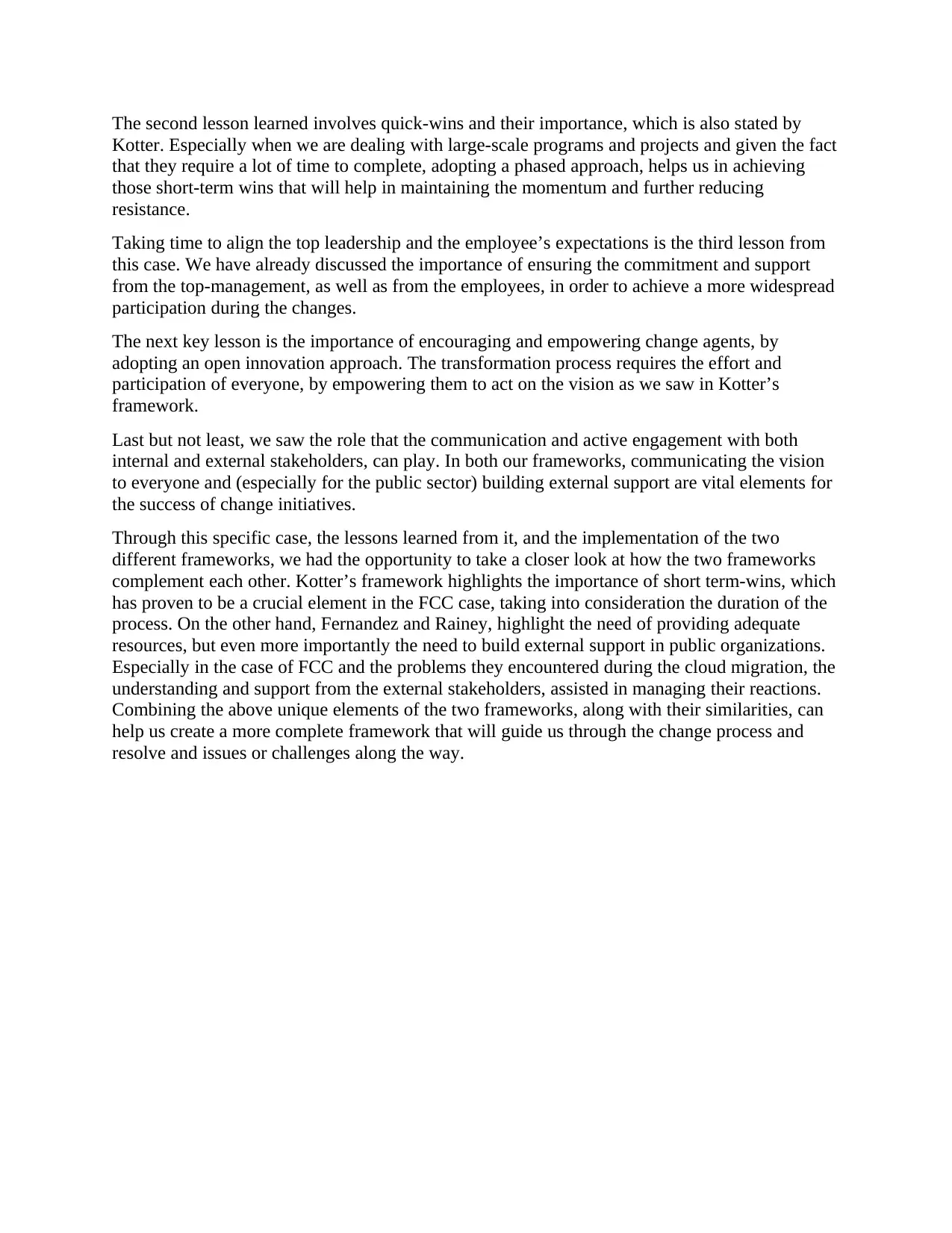
The second lesson learned involves quick-wins and their importance, which is also stated by
Kotter. Especially when we are dealing with large-scale programs and projects and given the fact
that they require a lot of time to complete, adopting a phased approach, helps us in achieving
those short-term wins that will help in maintaining the momentum and further reducing
resistance.
Taking time to align the top leadership and the employee’s expectations is the third lesson from
this case. We have already discussed the importance of ensuring the commitment and support
from the top-management, as well as from the employees, in order to achieve a more widespread
participation during the changes.
The next key lesson is the importance of encouraging and empowering change agents, by
adopting an open innovation approach. The transformation process requires the effort and
participation of everyone, by empowering them to act on the vision as we saw in Kotter’s
framework.
Last but not least, we saw the role that the communication and active engagement with both
internal and external stakeholders, can play. In both our frameworks, communicating the vision
to everyone and (especially for the public sector) building external support are vital elements for
the success of change initiatives.
Through this specific case, the lessons learned from it, and the implementation of the two
different frameworks, we had the opportunity to take a closer look at how the two frameworks
complement each other. Kotter’s framework highlights the importance of short term-wins, which
has proven to be a crucial element in the FCC case, taking into consideration the duration of the
process. On the other hand, Fernandez and Rainey, highlight the need of providing adequate
resources, but even more importantly the need to build external support in public organizations.
Especially in the case of FCC and the problems they encountered during the cloud migration, the
understanding and support from the external stakeholders, assisted in managing their reactions.
Combining the above unique elements of the two frameworks, along with their similarities, can
help us create a more complete framework that will guide us through the change process and
resolve and issues or challenges along the way.
Kotter. Especially when we are dealing with large-scale programs and projects and given the fact
that they require a lot of time to complete, adopting a phased approach, helps us in achieving
those short-term wins that will help in maintaining the momentum and further reducing
resistance.
Taking time to align the top leadership and the employee’s expectations is the third lesson from
this case. We have already discussed the importance of ensuring the commitment and support
from the top-management, as well as from the employees, in order to achieve a more widespread
participation during the changes.
The next key lesson is the importance of encouraging and empowering change agents, by
adopting an open innovation approach. The transformation process requires the effort and
participation of everyone, by empowering them to act on the vision as we saw in Kotter’s
framework.
Last but not least, we saw the role that the communication and active engagement with both
internal and external stakeholders, can play. In both our frameworks, communicating the vision
to everyone and (especially for the public sector) building external support are vital elements for
the success of change initiatives.
Through this specific case, the lessons learned from it, and the implementation of the two
different frameworks, we had the opportunity to take a closer look at how the two frameworks
complement each other. Kotter’s framework highlights the importance of short term-wins, which
has proven to be a crucial element in the FCC case, taking into consideration the duration of the
process. On the other hand, Fernandez and Rainey, highlight the need of providing adequate
resources, but even more importantly the need to build external support in public organizations.
Especially in the case of FCC and the problems they encountered during the cloud migration, the
understanding and support from the external stakeholders, assisted in managing their reactions.
Combining the above unique elements of the two frameworks, along with their similarities, can
help us create a more complete framework that will guide us through the change process and
resolve and issues or challenges along the way.
⊘ This is a preview!⊘
Do you want full access?
Subscribe today to unlock all pages.

Trusted by 1+ million students worldwide
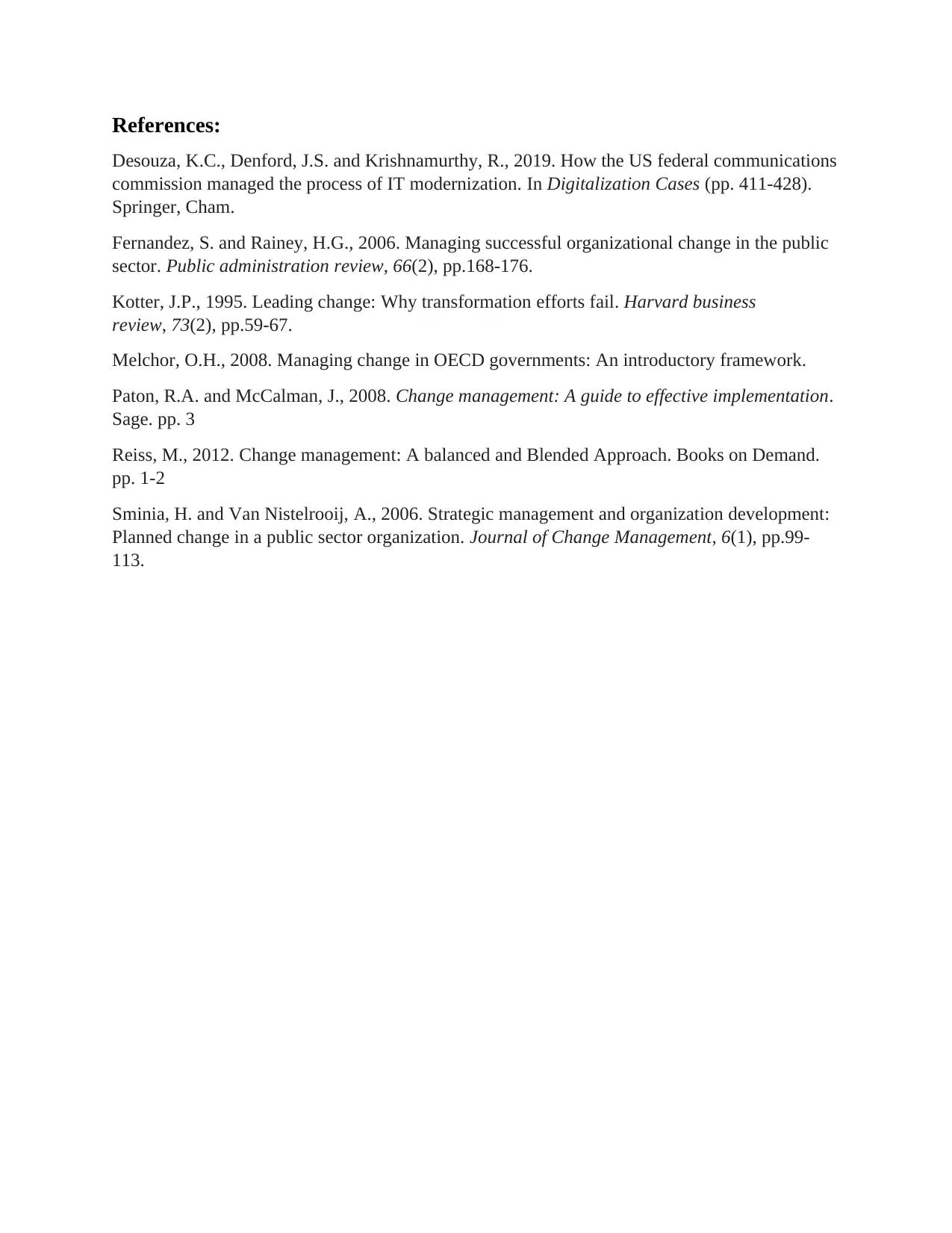
References:
Desouza, K.C., Denford, J.S. and Krishnamurthy, R., 2019. How the US federal communications
commission managed the process of IT modernization. In Digitalization Cases (pp. 411-428).
Springer, Cham.
Fernandez, S. and Rainey, H.G., 2006. Managing successful organizational change in the public
sector. Public administration review, 66(2), pp.168-176.
Kotter, J.P., 1995. Leading change: Why transformation efforts fail. Harvard business
review, 73(2), pp.59-67.
Melchor, O.H., 2008. Managing change in OECD governments: An introductory framework.
Paton, R.A. and McCalman, J., 2008. Change management: A guide to effective implementation.
Sage. pp. 3
Reiss, M., 2012. Change management: A balanced and Blended Approach. Books on Demand.
pp. 1-2
Sminia, H. and Van Nistelrooij, A., 2006. Strategic management and organization development:
Planned change in a public sector organization. Journal of Change Management, 6(1), pp.99-
113.
Desouza, K.C., Denford, J.S. and Krishnamurthy, R., 2019. How the US federal communications
commission managed the process of IT modernization. In Digitalization Cases (pp. 411-428).
Springer, Cham.
Fernandez, S. and Rainey, H.G., 2006. Managing successful organizational change in the public
sector. Public administration review, 66(2), pp.168-176.
Kotter, J.P., 1995. Leading change: Why transformation efforts fail. Harvard business
review, 73(2), pp.59-67.
Melchor, O.H., 2008. Managing change in OECD governments: An introductory framework.
Paton, R.A. and McCalman, J., 2008. Change management: A guide to effective implementation.
Sage. pp. 3
Reiss, M., 2012. Change management: A balanced and Blended Approach. Books on Demand.
pp. 1-2
Sminia, H. and Van Nistelrooij, A., 2006. Strategic management and organization development:
Planned change in a public sector organization. Journal of Change Management, 6(1), pp.99-
113.
1 out of 7
Your All-in-One AI-Powered Toolkit for Academic Success.
+13062052269
info@desklib.com
Available 24*7 on WhatsApp / Email
![[object Object]](/_next/static/media/star-bottom.7253800d.svg)
Unlock your academic potential
Copyright © 2020–2025 A2Z Services. All Rights Reserved. Developed and managed by ZUCOL.